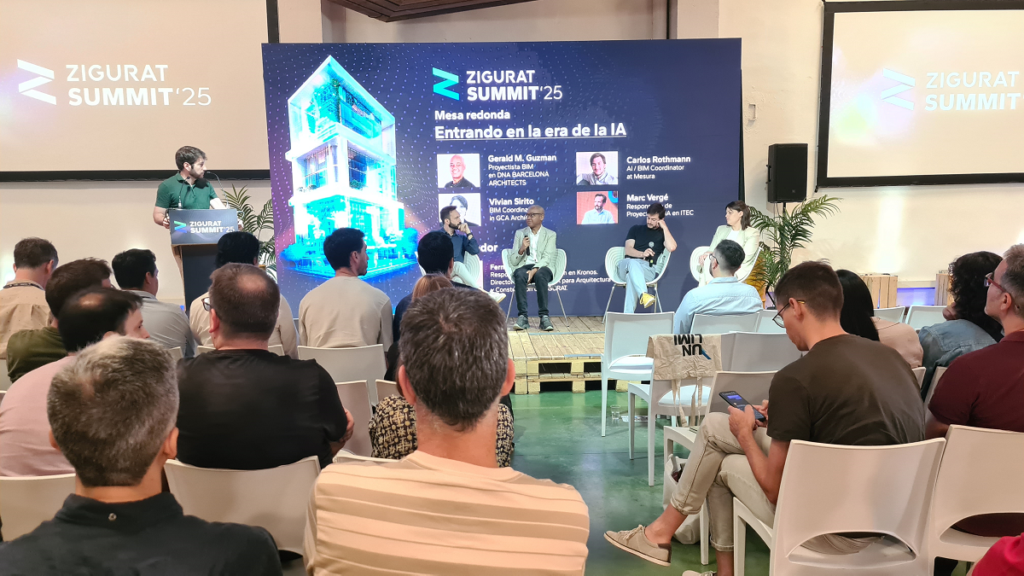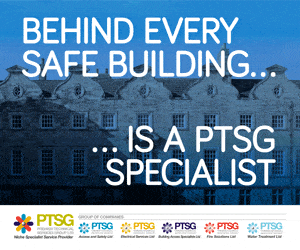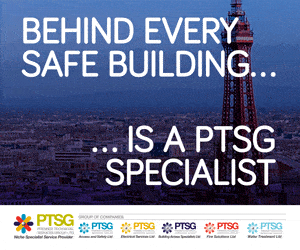The third edition of the ZIGURAT Summit, the international congress organised by ZIGURAT, has turned Barcelona into a key meeting point for the global debate on artificial intelligence applied to architecture, engineering, construction and urban management. Over 150 professionals came together as part of Student Week to explore the impact of AI from both strategic and practical perspectives.
The event, hosted at Valkiria Hub Space, was structured into two blocks: one in Spanish and the other in English. The first keynote, “Beyond the Hype: Technical and Human Challenges of AI in BIM”, was delivered by Fernando Iglesias, Head of Innovation at Kronos and Director of the Master’s in AI for Architecture and Construction. Using data, Iglesias explained the current explosion of AI: “We are at a moment of absolute convergence, where advanced robotics, cloud computing, big data and storage technologies are all reaching high levels of maturity.”
Iglesias called for the industry to move towards true interoperability among systems and tools, while stressing the need to prepare teams to rethink the way they design and collaborate. “Technical leadership must go hand in hand with ethical leadership – professionals need to be trained to make responsible, data-driven decisions,” he said.
Next, Carles Farré, co-founder of AECOTECH, stated that “AI won’t take your job – but someone using AI might.” In his talk “AI Agents On-Site: Your New Digital Allies”, Farré reviewed how the AECO sector has already experienced a first wave of digitalisation with tools like BIM, cloud platforms and ERP systems, which have boosted productivity. Now, however, “we are entering a new stage where AI agents can understand processes, make decisions, and support us in managing construction and projects.”
He emphasised that data is the key driver of change. “We are moving towards multi-agent environments, where intelligent systems will enable communication across data, companies, construction sites and teams,” he explained. This will allow real-time problem solving and optimised workflows. In this new scenario, professionals are not replaced – they are redefined. “We need adaptable, integrative profiles that can work side by side with AI,” Farré concluded.
The final Spanish-language talk was given by José Javier Laborda, Senior BIM Consultant at Ingecid, titled “Empowering the Expert: When Design Meets Automation”. Laborda presented a real case of digital transformation applied to a coastal engineering project in Santander. The challenge was to reshape a beach’s topography using BIM methodology within a company rich in technical expertise but with no prior experience in digital modelling.
Thanks to a flexible, scalable solution tailored to the team’s adoption pace, they reduced processes from weeks to mere minutes. “By the first month, we were already iterating and making informed decisions,” said Laborda, sharing figures including: up to 98% time saved in modelling, 80 automatic weekly iterations, and 87% fewer human errors due to mislinked drawings.
The English-language block featured three key presentations. Vicki Reynolds, Technical Director at One Creative Environments, Women in BIM ambassador, and Director of the Master’s in Global BIM Management, delivered a session on “BIM and the Impact of Lean”. She highlighted BIM’s central role as the structural backbone of all digital innovation in the AECO sector. “AI, smart assets, digital twins and automation can only be developed on a solid layer of data – and that starts with BIM,” Reynolds stated.
She explained that effective information modelling not only organises and validates data but also enables interoperability, scalability, and reliable automated decision-making. “Without proper information management, you risk ineffective automations or flawed analyses that compromise project efficiency,” she warned.
Reynolds illustrated her points with a case study using AI to convert drawings into 3D models, integrating IoT sensors and real-time data. “Any innovative project must begin with clearly defined information requirements. Without that, any attempt to scale or integrate new technologies will end up being costly and inefficient,” she concluded.
Next, Lilian Ho, Director of the Master’s in Artificial Intelligence for Architecture & Construction, presented “Digital Transformation through AI”. She explained the difference between AI and autonomous systems, noting that while AI learns and automates tasks, autonomous systems make decisions and act without human input.
She stressed the benefits of combining both to improve safety, efficiency, and on-site project management. “Integrating AI and autonomous systems enables 24/7 project monitoring, resource optimisation and real-time, data-driven decision-making,” she said. Ho clarified that these technologies don’t replace workers but transform their roles, requiring professionals trained to handle these tools across all phases of the construction cycle.
She concluded by highlighting how these technologies contribute to sustainability and waste reduction, while underlining the need for a real understanding of their application in order to generate tangible benefits.
Finally, Chris Dymond, founder of Unfolding and Director of the Master’s in Global Smart City Management, delivered the presentation “AI and Digital Twins: Advancing AECO and Smart Cities”. He argued that while smart buildings are essential, truly smart cities require a broader, more connected vision. He stressed the need for open standards and interoperability to integrate technologies flexibly, saying: “Smart building technologies are constantly evolving, with new applications and data uses emerging all the time.”
For Dymond, the success of a smart city lies not only in technical data, but in how it improves people’s lives, sustainability and resilience. “If there’s one area where we should apply AI in the interface between smart buildings and smart cities, it’s in developing AI-based assessments using the SRI standard to understand how intelligent a city really is – based on the intelligence of each individual building,” he said.
The day included two roundtable discussions, which sparked intense dialogue between speakers and audience. The first panel featured Vivian Sirito, BIM Coordinator at GCA Architects; Carlos Rothmann, AI/BIM Coordinator at Mesura; Gerald M. Guzmán, BIM Designer at DNA Barcelona Architects; and Marc Vergé, Head of AI Projects at ITEC. The second featured Vicki Reynolds, Lilian Ho and Chris Dymond, moderated by ZIGURAT professor and Director of the International Master em Gestão de Projetos na Construção Bruno Mota.
SUMMIT 2025 and Student Week
The ZIGURAT Summit took place as part of Student Week, a series of activities designed for ZIGURAT alumni to foster connections, learning, innovation, and collaboration among AECO professionals.
Over four days, participants engaged in an intense programme combining advanced training, visits to innovative projects, and networking events.
Highlights included a startup creation workshop, where participants worked in teams to develop entrepreneurial proposals. The winning projects received certificates and tailored mentoring at the Barcelona Contech Hub, a support space for disruptive initiatives in construction technology.
The programme also featured speed networking sessions, talks, and an architectural tour of Barcelona led by professionals involved in the city’s urban transformation.





















































